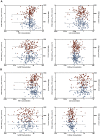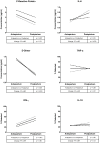Immune activation markers in peripartum women in Botswana: association with feeding strategy and maternal morbidity
- PMID: 24657960
- PMCID: PMC3962339
- DOI: 10.1371/journal.pone.0089928
Immune activation markers in peripartum women in Botswana: association with feeding strategy and maternal morbidity
Abstract
Hormone levels shift the immune state in HIV-uninfected pregnant and breastfeeding women away from Th1 responses and toward regulation to permit fetal tolerance. Limited data exist on inflammation during pregnancy or postpartum in HIV-infected women, though certain inflammatory markers are associated with adverse health outcomes among HIV-infected persons. We measured hsCRP, D-dimer, IFN-γ, IL-6, IL-10 and TNF-α at 34 weeks gestation and six months postpartum in HIV-infected women from the Botswana Mashi PMTCT trial who were randomized to breastfeeding or formula-feeding. Differences in inflammatory markers between gestation and postpartum periods, and by randomized feeding method, were estimated using generalized estimating equations, adjusting for baseline plasma HIV-1 viral load, CD4 count, calendar time, and antiretroviral treatment status. Additionally, we studied the association between marker concentrations at six months postpartum and major adverse clinical events over the following 4.5 years, using case-cohort sampling and adjusted Cox proportional hazards models. In 86 breastfeeding and 75 formula-feeding women, hsCRP and D-dimer decreased significantly between 34 weeks gestation and six months postpartum, while IFN-γ increased. There was no significant association between inflammatory marker change and randomized feeding method after adjusting for multiple comparisons and removing outliers. In univariate analysis, TNF-α, D-dimer, and IFN-γ concentrations at six months postpartum were significant predictors of subsequent clinical events, and TNF-α remained significant in multivariate analysis (HR = 4.16, p = 0.001). In young HIV-infected women in Botswana inflammatory marker concentrations did not differ significantly between women who breast- vs. formula-fed. However, postpartum TNF-α level was predictive of subsequent adverse clinical event.
Conflict of interest statement
Figures



References
-
- Weetman AP (2010) Immunity, thyroid function and pregnancy: molecular mechanisms. Nat Rev Endocrinol 6: 311–318. - PubMed
-
- Cutolo M, Sulli A, Seriolo B, Accardo S, Masi AT (1995) Estrogens, the immune response and autoimmunity. Clin Exp Rheumatol 13: 217–226. - PubMed
-
- Yu-Lee LY (2002) Prolactin modulation of immune and inflammatory responses. Recent Prog Horm Res 57: 435–455. - PubMed
-
- Zimmer JP, Garza C, Heller ME, Butte N, Goldman AS (1996) Relationship between serum prolactin, lactation and changes in maternal blood B-cell (CD19+) percents during the first 8 months post-partum. J Reprod Immunol 30: 81–95. - PubMed
Publication types
MeSH terms
Substances
Grants and funding
LinkOut - more resources
Full Text Sources
Other Literature Sources
Medical
Research Materials

